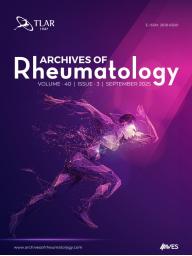Association of Health-Related Quality of Life with Functional and Radiological Outcomes in Patients with Rheumatoid Arthritis–Associated Interstitial Lung Disease, Systemic Sclerosis–Associated Interstitial Lung Disease, and Idiopathic Pulmonary Fibrosis
Main Article Content
Abstract
Background/Aims: This study aimed to investigate the association between lung function and imaging parameters with health-related quality of life (HRQoL), as measured by the St. George’s Respiratory Questionnaire (SGRQ), in patients with rheumatoid arthritis–associated interstitial lung disease (RA-ILD), systemic sclerosis–associated ILD (SSc-ILD), and idiopathic pulmonary fibrosis (IPF).
Materials and Methods: In this cross-sectional study, a total of 120 patients (37 RA-ILD, 42 SSc-ILD, and 41 IPF) were included. Demographic, clinical, functional (forced vital capacity [FVC], lung diffusion capacity for carbon monoxide [DLCO], 6 minute walk test), and radiological (Warrick scores) data were collected. The associations between SGRQ scores and these parameters, as well as other patient-reported outcome measures (PROMs), were analyzed.
Results: St. George’s Respiratory Questionnaire scores showed significant correlations with functional measures and PROMs across all groups. However, no correlation was found between SGRQ and FVC only in RA-ILD. In SSc-ILD and IPF, SGRQ scores were also significantly associated with high-resolution computed tomography–based Warrick scores. However, no correlation was found between SGRQ and radiological parameters in RA-ILD. Receiver operating characteristic (ROC) analysis demonstrated that SGRQ could help identify patients with impaired lung function (FVC <70%) in IPF and SSc-ILD groups.
Conclusion: St. George’s Respiratory Questionnaire may be a valuable tool for evaluating HRQoL in patients with SSc-ILD and IPF, with moderate associations with functional and radiological outcomes. Its utility in RA-ILD appears to be more limited and requires further investigation.


